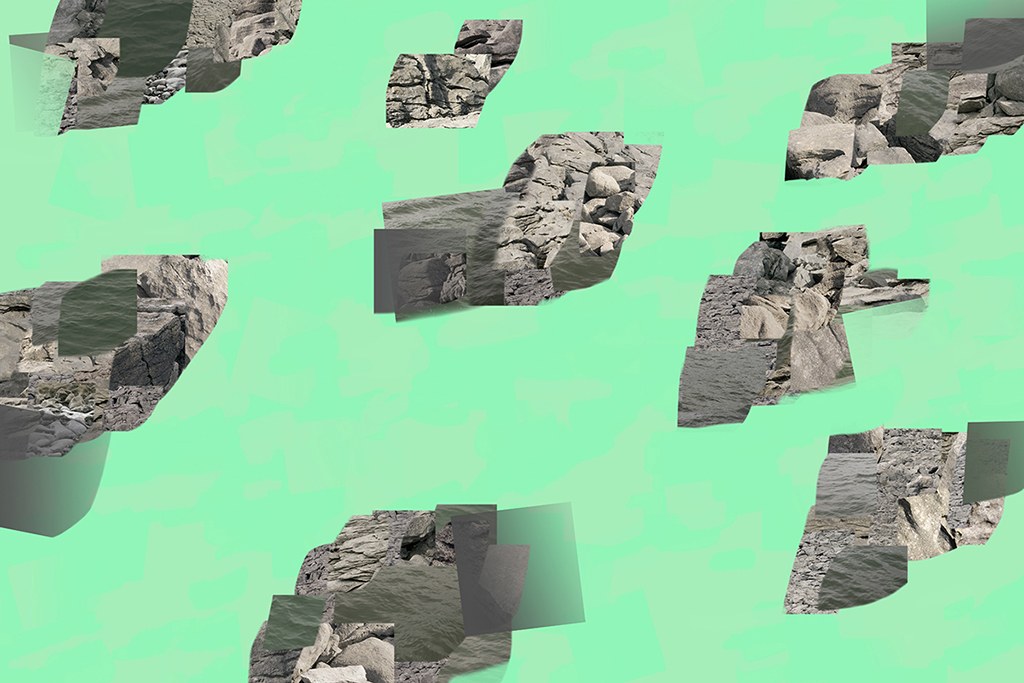I came to Sandnes and southwestern Norway to work with the idea of the coast, or coastline, as an abstraction — an abstraction that might make it easier to fully consider the real thing. Because this is something that abstraction and photography can both do, in varying ways: incite an experience beyond representation.
I think a lot about the relationships between abstraction and information: how information can be a kind of abstraction; how abstractions themselves can convey information; and what types of “information” they can convey. A scientific graph is just an abstraction of some measurements without the knowledge required to read it and give it meaning. Models of atmospheric flow or sea currents appear abstract, but are precise visual representations of incredibly complex flows of information. A photograph, too, is an abstraction or translation of an actual moment, experience, or place, despite its deceiving potential to reproduce it; it is something other than what that original moment was, leading me to ask if it is at all possible to record a moment any more “objectively” than that (and, if so, with which tools). Even my own view of a landscape becomes abstracted as it is internalized, affected by what I know, how I think, how I see, how I remember. Can an abstract artwork be a kind of measure, record, or document of a place or an experience — by producing another experience, intended for a viewer?
The coast and the coastline — at least what those linguistic terms are intended to suggest — are abstractions. The coast is where land and water meet, but it is not really much more concrete than that. Perhaps it is where specific physical or fluid-dynamical behaviors occur or transform; certainly it is home to the more easily measurable effects of erosion or climate-change-induced sea level rise. But a coast itself might just be the conceptual-physical idea that emerges from the meeting/interacting of these two primary elements. Consider a spectrum of material: water to land, land to water.
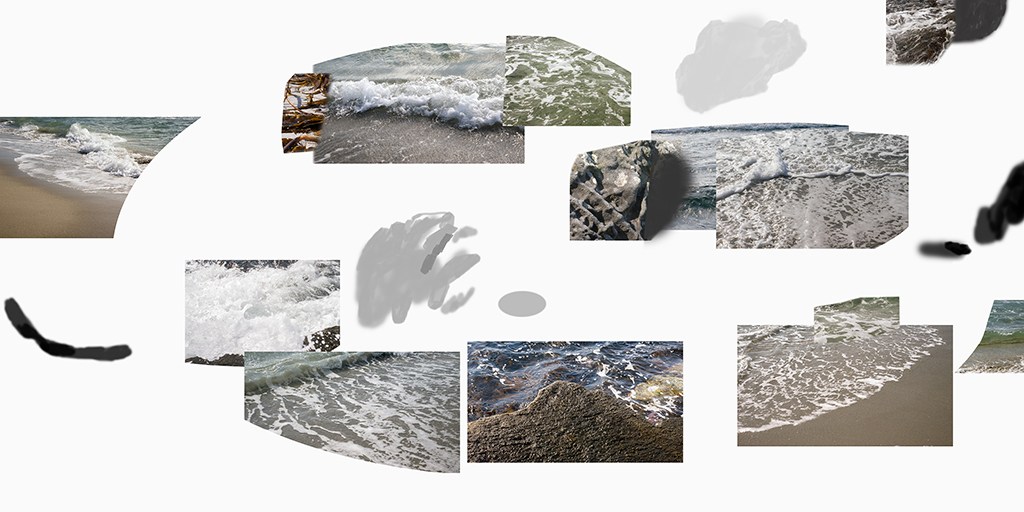
coast- a region where the land and water overlap, making a third, less tangible and less definable zone, one with no edges, perhaps only margins
-line lines are defined, but only in two dimensions. A coastline would have to be, firstly, at least a three-dimensional line: a line that moves in space horizontally and vertically, as waves peak and crash, sweep over rocks, rearrange sand, and seep down into the beach, making momentary muted shapes in the land before it all repeats. But this motion is beyond the capabilities of a line, because what is a three-dimensional line, and where could that line lay, anyway? That line can’t trace the moving edge of the sea, because the closest one can get to an “edge” of the sea would be to somehow track the entire surface of the water: an edge created by the surface-tension pull of water molecules bound so strongly together that they maintain their material properties against the molecules of the neighboring sea air or surrounding land. But imagine how complex that surface-edge is — even at rest, if the water was still — and becomes — when a wave, even just one, hits the beach and breaks apart, separating into the water that sinks down into the ground, or that which is pulled back into the ocean by residual energy. And even if this complexity was somehow traceable, it still must remain an edge in many dimensions, as this “edge” of the sea itself has many dimensions; even if it could resemble a line, this “edge” could only be a four-dimensional line, one that moves in x, y, and z directions, spatially and physically, but also in t (time): a line that moves in space and time, and has been moving forever in time.

The sea that lines southwestern Norway is the North Sea. It sits to the south of the much larger Norwegian Sea, and is considered a “marginal sea”: a sea on the margins of the Atlantic Ocean (by definition, a marginal sea “separates coastal zones from open oceans”). The North Sea is shallow, measuring only 100 meters in depth on average. On the northeastern periphery of the North Sea is the Norwegian trench, a dramatic shift in oceanic terrain just before the land begins. The trench is a deep dip in the sea floor, running alongside southwestern Norway between the Stad peninsula in the north and Oslofjord in the south. It ranges between 50-95 kilometers in width and 250-700 meters in depth, and formed due to some combination of tectonic and ice stream activity over the last 1.1 Ma — or 1.1 million years.
The Rogaland anorthosite guidebook, page 26, states that the coastal rocks which lie between Brusand and Sirevåg are anorthosite with aggregates of megacrysts of ortopyroxenes and plagioclases (Brusand, Ogna) and homogeneous leuconoritic anorthosite (Sirevåg). This region, called the Egersund-Ogna Massif, is described in the Guidebook as follows (to fully appreciate the terminology, its level of specificity, and its form): “The Egersund-Ogna massif (EGOG) is an anorthositic dome, approximately 20km in diameter, emplaced in granulite facies terranes. Petrographically and chemically, the anorthosite is monotonous at large and made up of granulated, equal-sized (1-3cm), homogenous plagioclase (An40-45) with locally some megacrysts of orthopyroxene and plagioclase. The marginal zone of the massif (1-3km thick) is leuconoritic on the average and presents a pronounced gneissic texture.”
The authors then present one theory describing the region’s geological formation. This theory was later disproved, at least partially, but is still worth reading: “… the anorthosite, in a mushy stage, lubricated by a minor amount of interstitial liquids and containing megacrysts or aggregates of megacrysts, forms at depth, rises diapirically in the crust and produces its own deformation along the walls and within the mass. A ballooning process locally leads to the foliation of marginal parts and also sufficiently deforms the external metamorphic envelope (syn-emplacement deformation) to achieve parallel structure on both sides of the contact. A final telescopic flattening of the whole system extends the area of the massif by bringing the root of the diapir near its roof in a central position.”
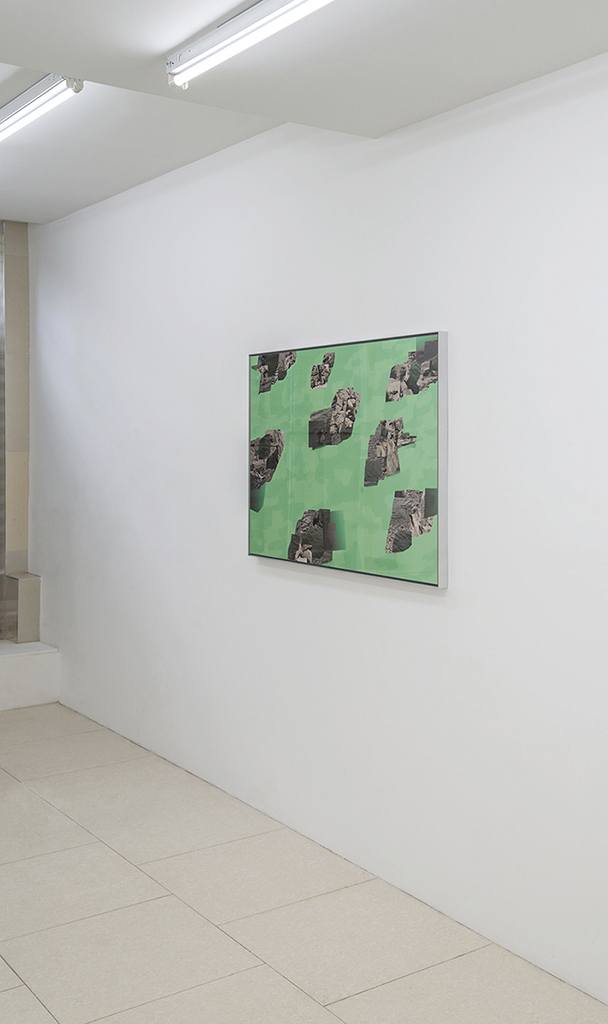
Any definition of a fixed coastline must be relative, given how continents and landmasses have shifted throughout geologic eras. There’s something in how we think about geological history, how we talk about when things “formed” — in the past tense — as if change to our geological landscape was something that happened, but no longer happens. Today’s idea of a “forming” landscape relies on a sense of fixity upon which, perhaps, it never quite made sense to have. Our present conception of a landscape “forming” refers only to a change from what we considered normal — a change that happens quite rapidly, I imagine, compared to the speed with which geologists might use the word “formed.” In this case of the coast, where forms of water and rock constantly shape one another, we should consider the roots of these ongoing processes: global systems at play, way beyond our comprehension.
Forming coast/lines are made of forms: geological forms, wave forms, blurred water-forms that sink into the sand. These materials take form (the noun) as they form (the verb), but immediately transform again — a constant process, forever repeating in slight variation. How to think about these interactions? How do these elements relate to one another?
Early in 2016, during some time in Ireland, I made an artwork (the first, in my consideration of the coast) with these questions in mind. What happens when I photograph rocks, and photograph water, and put these images next to one another, in groups, within a larger, abstracted digital image? Water, when photographed, becomes solid and still; in the finished work, the water images so closely resemble the rock images that one doesn’t even distinguish them on first glance. Photography freezes time, and it transforms material. So could this be a more “true” picture of a coast: a constructed image where these two decisive materials become one another, transforming into something that is neither, but both?
The coastal regions northeast of the Atlantic are the shores where the warm Gulf Stream-turned-North Atlantic Current ends its travel. Here, it hits land (the rocky shores of western Ireland, for example) or shifts and evolves into the north-heading Norwegian Current, where it runs along Norway’s snaking margins before pushing yet further to the Arctic Ocean. So there, in Rogaland, southwestern Norway, are Brusand and Ogna: the beaches where I went to look at the land and the sea, to think about the coast, to watch it form, as these waves (the North Sea/Norwegian Trench/Norwegian Current/marginal sea waves) hit the rocky shore (the anorthosite — homogenous, or with aggregates) and the sand (formed gradually, over thousands or millions of years, as these rocks weathered and eroded). The beaches of Ogna and Brusand are pristine and clean; Norway’s oil-drilling platforms float somewhere on the sea, just beyond the horizon.
“There are no actual boundaries between one range of wavelengths and another, because nature did not present us with sharp edges… “What is the outline? The outline is only the edge difference between light and dark or one color and another. It is not something definite. It is not, believe it or not, that every object has a line around it! There is no such line. It is only in our own psychological makeup that there is a line.”
–Richard Feynman
One day, while sitting on the rocks at Ogna, I thought about how beaches typically feel so open, so wide, extending out in all directions. Yet a beach has a dual nature, as it is both a vista and a boundary: a blurry, but extant, shift between land and sea; the hazy edge of both. “Edge” is such a harsh word; it represents a hard line, not at all penetrable or flexible. There is such a contrast between the tone of this word, edge, and the view of the waves hitting the beach — or beyond, out towards the sea. Perhaps a mountain peak or cliff exhibits a similar kind of edge, marking the meeting-point of hard rock and open sky. The idea of a vast, open edge is a beautiful incongruity.
A line is a kind of edge, acting as a boundary, an almost unavoidable separating formal force. But perhaps lines (edges) are only geometric objects: conceptual, not physical, forms. Physicist Richard Feynman writes about edges and lines in his Lecture 26, Optics: The Principle of Least Time: “There are no actual boundaries between one range of wavelengths and another, because nature did not present us with sharp edges. The number associated with a given name for the waves are only approximate, and, of course, so are the names we give to the different ranges.” He then goes on to ask: “What is the outline? The outline is only the edge difference between light and dark or one color and another. It is not something definite. It is not, believe it or not, that every object has a line around it! There is no such line. It is only in our own psychological makeup that there is a line.” Feynman refers to the waves of the electromagnetic spectrum, and the different names we have assigned sections of its component wavelengths — most of which humans cannot see, but which pass everywhere around us at all times: radio waves, microwaves, terahertz radiation, infrared, visible, ultraviolet, x-rays, gamma rays. (What is it like, this world of waves?)
The word wave refers to a type of form (a wave form) or a category of behavior (the behavior of waves), not to a specific material. Consider electromagnetic waves, water waves, sound waves, quantum waves of matter. It is more correct to imagine the “materials through which waves move” rather than movements of a wave itself; waves are defined, most simply, as “disturbances that propagate energy through a medium.” Most ocean waves are wind waves, driven by wind energy; water waves are transmissions of energy, not water mass, across the surface of the ocean. Every hit of a wave onto the coast is an energy transfer coming from elsewhere — the actual water molecules themselves don’t travel so far.
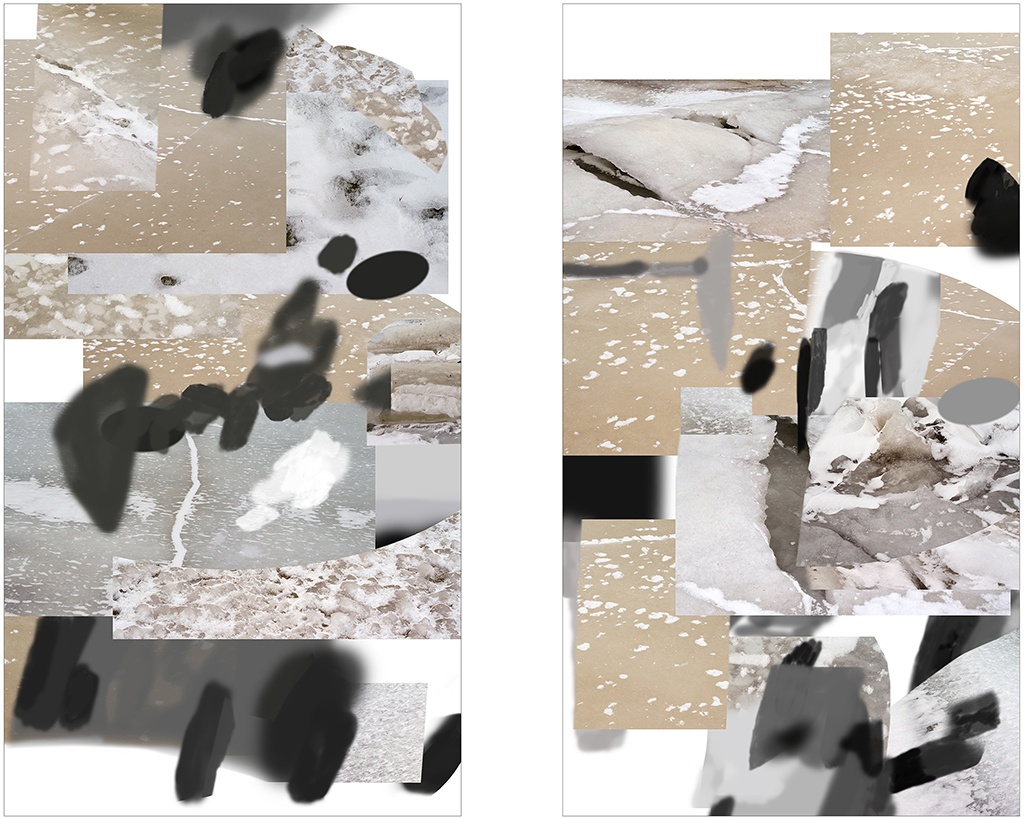
The North Sea doesn’t freeze in the winter (its average temperatures range between 6ºC and 17ºC), though it can be stormy. The same ocean currents that transport energy as waves from west to east bring warm water and temperatures to the beaches of southern Norway year-round. Watching the waves at Ogna and Brusand in late summer made me think about the ocean at different seasons, and what this place would be like if the sea did freeze — perhaps like it did in an earlier era, an icier age, when there were glaciers, the glaciers which eventually gave way to the ice streams which themselves gradually formed the deep trench along Norway’s coast.
Earlier in the year, I had visited a frozen sea: the Bothnian Bay, which lies between northern Finland and Sweden, and freezes solid all the way across, from land to land. One evening, at sunset, a local photographer and ice-fisherman drove me out onto the sea ice near Ii, Finland. We stood there for a long while. It was -20ºC. I kept looking west; I could see only snow-covered sea ice all the way to the horizon beneath the quickly-dimming sky. Sea ice is not as flat as lake ice, or calm river ice; at least some of the wave forms freeze into frozen frothy shapes, preserved until the temperatures shift. The unevenness is striking; what has a stronger force, the energy-driven movement of the wave, or the bonding strength of water molecules freezing into ice?
There was a sense of tremendous latent energy or power out on the sea ice, something I hadn’t felt on the land. Maybe it was my awareness that we were really standing on the sea. Or perhaps it was actually a decided lack of physical energy that I was feeling, a lack due to the cold temperatures: the rigid and dense absence of energy which keeps the ice bonded so firmly together. Because once energy — in the intrusive form of heat — enters the system, the ice, of course, will loosen and melt.
It made me wonder, then, and again when I was at Ogna (where I had my feet in the water, though only for a short time): what role does ice play in this consideration of the coast? If a coast, or coastline, is not fixed, not concrete, because the water never stands still, then what about the coast along a frozen sea?
I don’t really remember the precise moment when the car passed from the land, near Ii, out onto the sea. Since it was all frozen, did that transition even really happen the way it normally would when moving from land to sea, a transition where different laws of physics gradually emerge to prominence? We had driven from snow-covered icy land to snow-covered, three-meter-thick sea ice, and this uninterrupted snow-ice surface was its own type of terrain. Water relates to the land quite differently as a solid than as a liquid, and all of it presents the idea of a coast in a very different way.
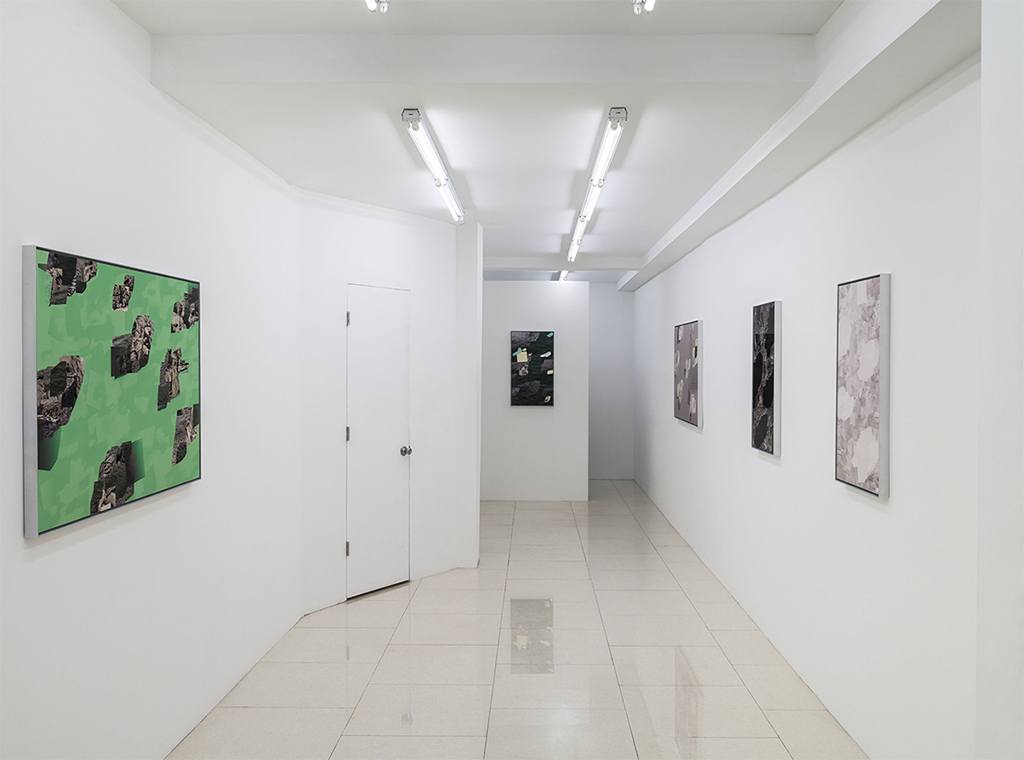
Blurred edges have implications for image-making, as well as the potential to question whether the defined borders, boundaries, and concepts that humans have imposed on the world really make sense. Could it be possible to live in a world where boundaries, and environmental and societal facts (what is needed for the well-being of the earth and its inhabitants) exist alongside the true hazy edges of coasts: the potential for indeterminacy? (How do I look at the world?)
I was photographing and shooting video at Ogna, thinking about how this might all come together into finished work (a video, and abstract photographic prints) and about the forms I would add to this material so based in the real world — so as to not disrupt that reality, but rather, to heighten it. I realized that a few individual shapes or gestures superimposed on a video could focus your gaze in a way that makes you aware of your engagement in an act of looking — and thus suddenly seeing something in a different way. In Coast forms (the resulting video work), and in Soft Edge (Rogaland) (a digital print on fabric) and Spectrums 3 (a digital c-print), the digital forms take on a multiplicity of roles, flipping back and forth between the transitory froth of a wave, the solid permanence of a rock, and the general immateriality of something abstract and in between.
I am often asked what these shapes are, the digital forms in my work — present as abstract gestural marks; small, soft-edged elliptical solids; or large, hard-edged elliptical windows. They are, simply, forms: but forms that shift, which stand in for an observation or perception, or reflect just how flexible form itself can be. They are there because of the ways they affect familiar, natural things; how they compress space, or expand it; how a beach is no longer just “a beach”; how different materials can relate; how reality and imagination, or reality and digital space, can, and do, co-exist; how we should be aware of that fact, and think about it.
There is a lot of language — a lot of hovering information — in my work. But there is also a point where this information drops off, sliding into abstraction and shifting the focus from nature (and its “data”) to something more experiential and intuitive. The digital forms facilitate this transition; they give it form, augmenting the expressiveness of the natural world. They project my observations and measures — the ways I read these landscapes and my photographs of them — but they are not textual. They do not explain themselves, or their logic, though logic is present. Instead, they are visual forms which can imply what may not be immediately visible, be it scientific information, an observer’s experience, or natural activity at scales we can’t perceive. They invite their own interpretation: nature is made of forms, and form provides observational information that becomes both experience and knowledge.
Leah Beeferman, Coast forms, 2017. Digital video and animation, no sound.
Some years ago, I first saw a map of the cosmic microwave background (CMB) radiation, collected by NASA and the European Space Agency. I was equally drawn to the image itself — presented as an elliptical, pseudo-cylindrical map projection (also known as a Mollweide, elliptical, or homolographic map projection) — as I was to the fact that this colorful map somehow represented the electromagnetic radiation left over from the Big Bang; the average temperature of the universe (2.7260±0.0013 K, or -270.424ºC); and the universe itself, in its entirety, as an abstract image: one that suggests and represents everything, including and beyond us, in space and time. The ellipse itself is expansive: a form in two-dimensions that allows for thinking far beyond two dimensions.
When transferring information from the “real world” into an image, what one can ask of photography, or of abstraction? In nature, basic properties of matter (density, form, structure, color) emerge via complex geological, chemical, and biological systems, each guided by the interactions of subatomic particles. Some of these processes are observable, reflecting light in the visible spectrum back to our eyes or lenses; others are visible only to more specialized measuring tools, or to certain animals, which can see beyond those familiar wavelengths. The rest exists, to us anyway, perhaps only on a textual or numerical layer interwoven within: a layer expressed primarily in the languages of science or mathematics (that structured abstraction), visualizable, or perhaps not. Or it exists in the realm of lived or observational experience, where these layers of the visible, the textual, and the imagined are compressed into one complicated block, viewed, I suppose, only from within.
Artists are often asked to imagine new futures, but maybe we first need to re-imagine the present: to consider how we see and what we can’t see, in order to build a stronger foundation of looking, more attuned to the world itself, and, in turn, to our images of it. So I think about Eliot Porter, 1987: “As I became interested in photography in the realm of nature, I began to appreciate the complexity of the relationships that drew my attention.” And about Rebecca Solnit, writing about Porter in Every Corner is Alive, 2003: “Some of Porter’s flat-to-the-picture-plane images bring to mind [abstract expressionist] painting and even may have been influenced by it. Abstract expressionism famously emphasized the formal process of painting itself, or what in Jackson Pollock’s work was sometimes called ‘all-overness.’ Porter’s photographs exhibit a similar compositional approach, as well as a passion for process in ecological, rather than purely aesthetic, terms.” And about Luigi Ghirri, in Atlas, 1973: “Photography, with its power to constantly vary our relationship with reality, shifts the terms of the question, evoking an ‘illusory’ form of naturalness. In this case, reality and its conventional representation seem to coincide, and there’s a shift from the question of its meaning to that of its imagining. And so the journey lies within the image, within the book.”


